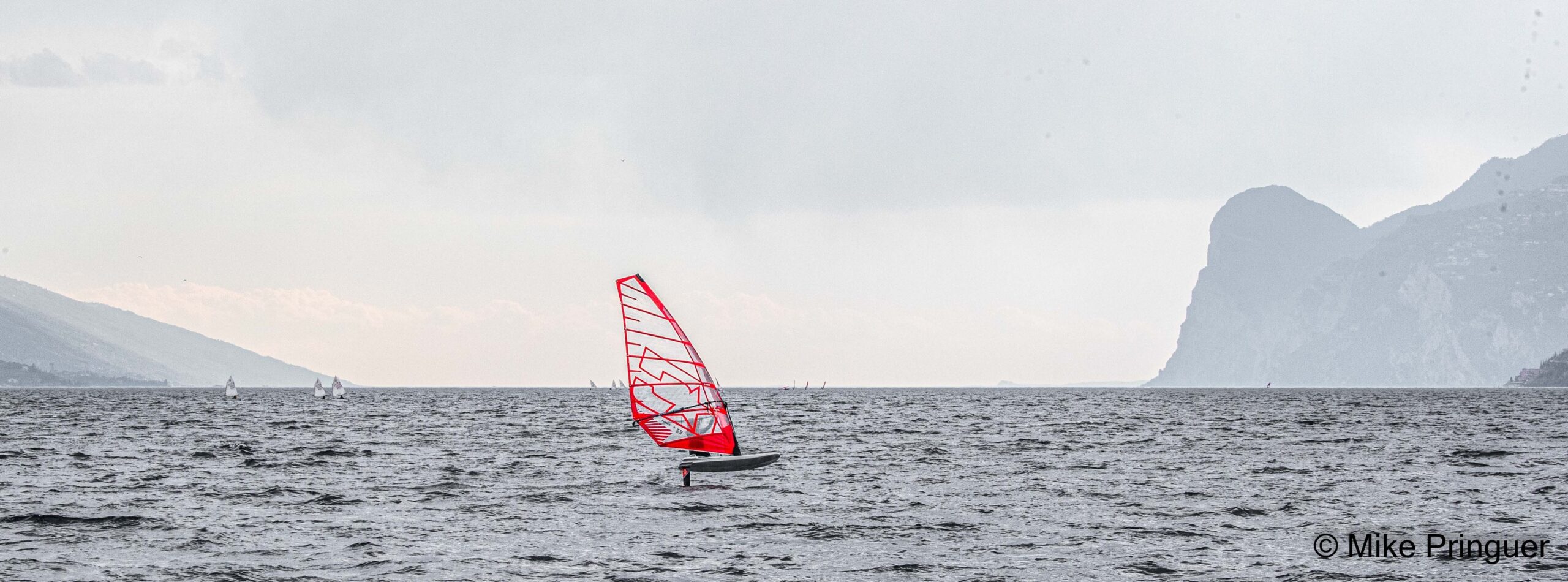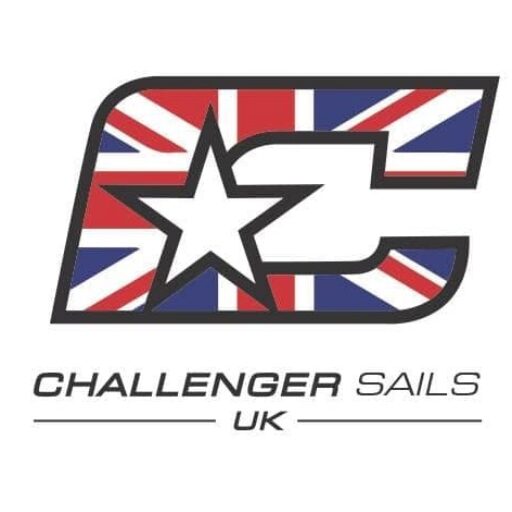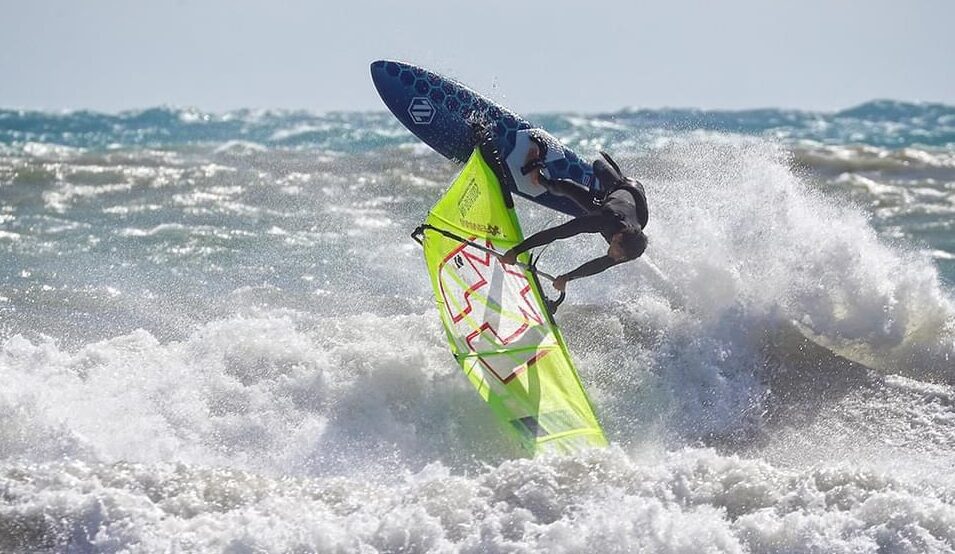Your basket is currently empty!

Windsurfing is super addictive. Ever since sailors and surfers worked out that combining the two disciplines would result in something fun windsurfing has gained fans the world over. In 2023 the sport is well established with plenty of riders still battling with Mother Nature via sail and board power.
Things have evolved considerably though since those heady first windsurfing forays. And whilst other disciplines aim to take away windsurfing participants there’re still plenty who do with new recruits coming up every season.
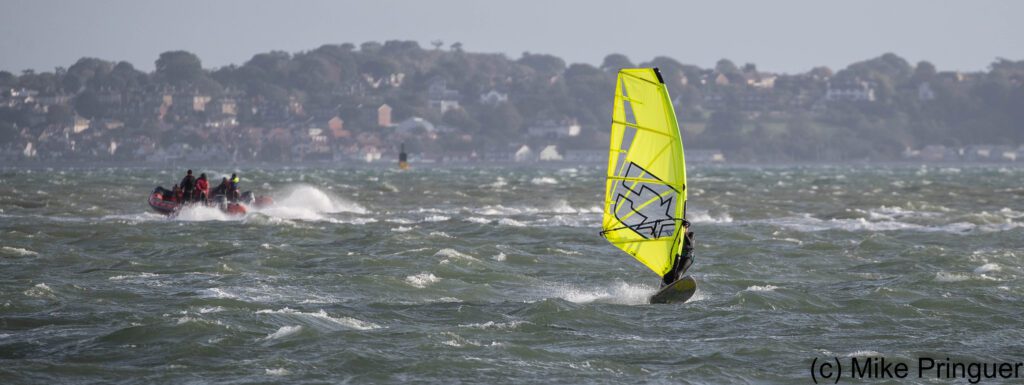
Windsurfing history.
Windsurfing was invented in 1958 by a young Peter Chilvers on Hayling Island, south coast, UK. An inquisitive and engineeringly minded 12 year old Peter fitted a makeshift sail to a ‘board’ and began gliding around one of Hayling’s tidal creeks whilst standing up. This set in motion a chain of events that would lead to the explosion of windsurfing proper at the end of the 70s and into the 80s.
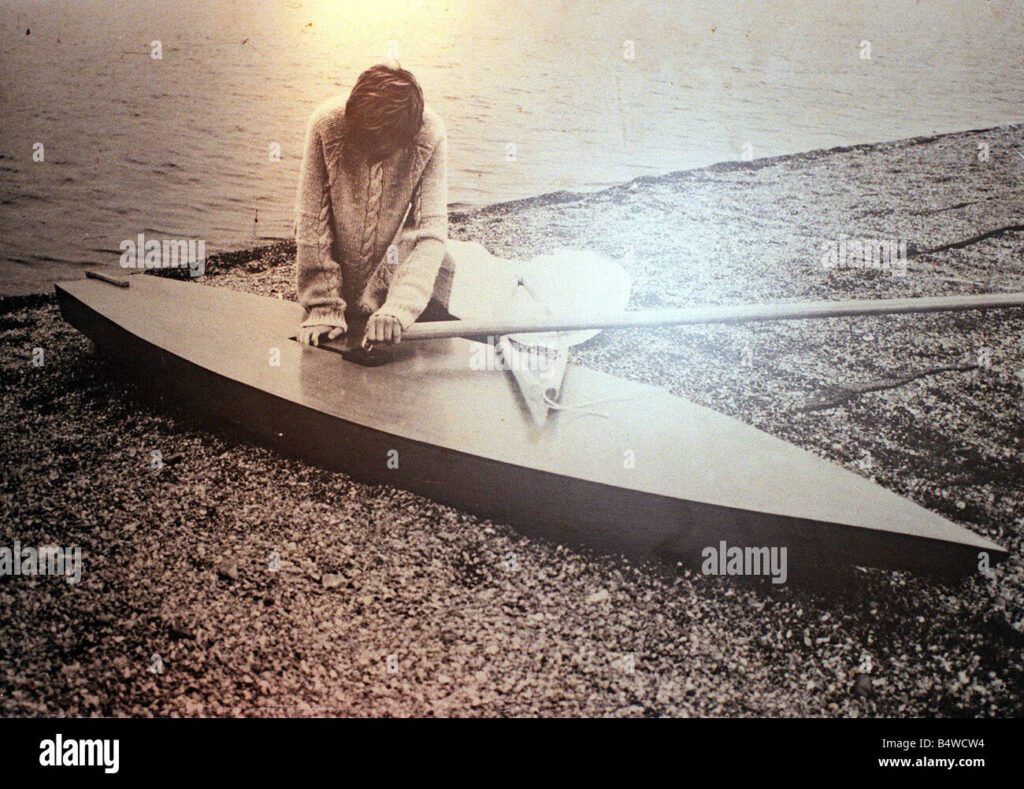
American’s Hoyle Schweitzer and Jim Drake took Peter’s windsurfing concept, refined it and delivered mass-appeal equipment to the public with their patented ‘Windsurfer’ ten years later in 1968.
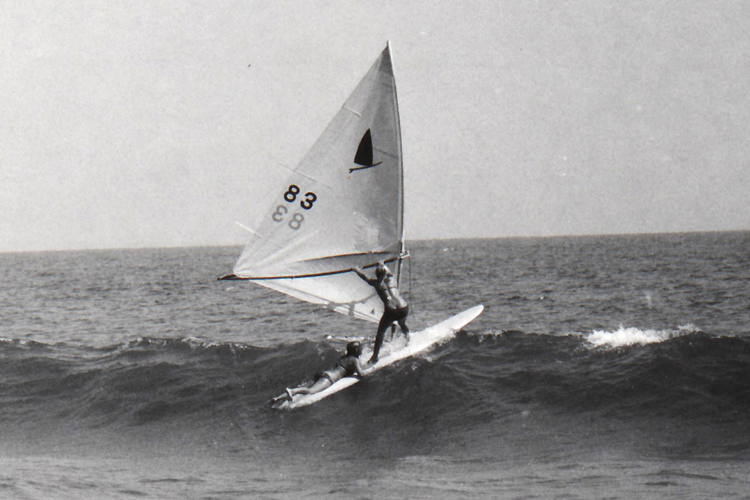
The 80s saw a bitter legal battle fought between Windsurfing International and Tabur Marine relating to the patent of windsurfing. Schweitzer/Drake with Windsurfing International took legal action against Chilvers’ Tabur Marine but lost the case after Chilvers demonstrated his original design in use.
Whilst the 1958 original craft differed in some ways to that of the more modern version it was deemed to have all the necessary elements that made it the very first, and therefore Chilvers’ creation. The case set precedents for further patent lawsuits that still stand to this day.
BBC’s The One Show featured the story back in 2009 which you can view by following this link – https://en.wikipedia.org/wiki/The_One_Show
Windsurfing as it stands today (2023).
Windsurfing’s come a long way since those heady fledgling days. What was, in the beginning, a non-planing sail sport has evolved into something much more versatile and broad. Riders can now tackle hardcore waves, race one another (in various formats), perform awe inspiring tricks (much like freestyle motocross), fly above the water (ala windsurf foiling) or simply cruise around.
It can be a family oriented activity, social get together or solo pursuit.
Whether coming at windsurfing from a surfing point of view or sailing led perspective windsurfing accommodates. It can be whatever you want it to be. All a rider needs is water, a sail and a board. From there you’re good to go.
What’s windsurfing like in the UK?
Here in the UK we’re blessed to have many choices of waterway – from inland to coastal – for our windsurfing shenanigans. Wherever you’re based there’ll be a stretch of water, ripe for windsurfing fun, not too far away. With the right style of equipment, for said location you choose, any sailor is poised to get afloat and have some fun.
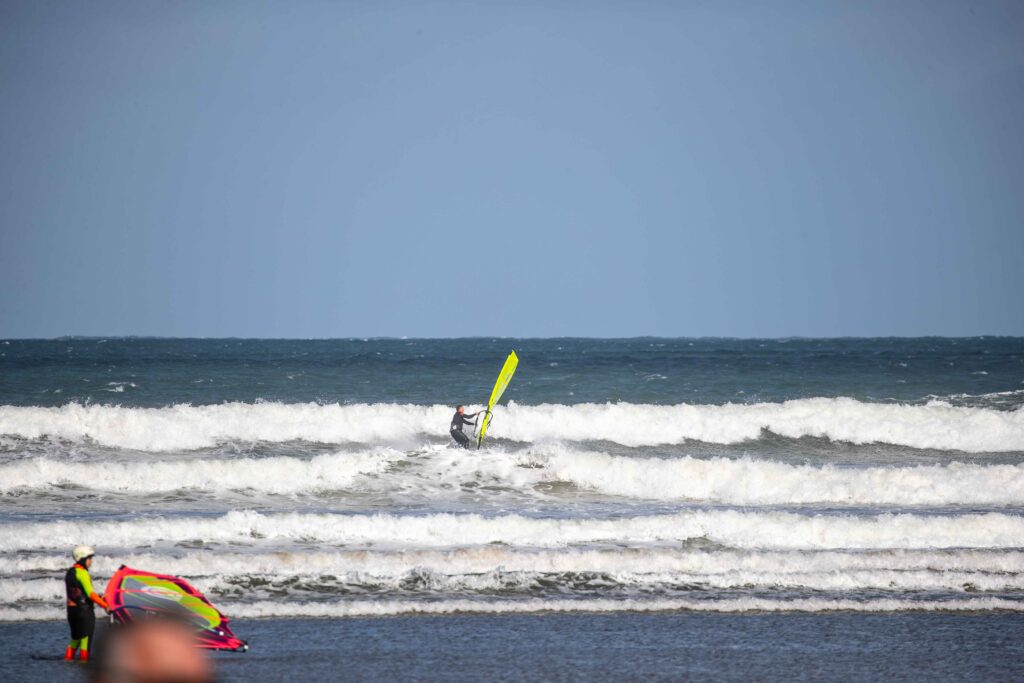
During summer there are plenty of windsurfers to be found around the country. If there’s breeze you can often find sailors enjoying the conditions. High season is much warmer than winter months, which as such see more fair weather riders taking to the water. When it gets colder it’s mostly the more committed and experienced windsurfer out amongst it.
There’s a thriving youth scene with a healthy number of young windsurfers enrolling in windsurfer sailing programmes. At the other end of the scale you have a hardcore elite of riders constantly aiming to sniff out the strongest winds and biggest waves. In between there’s every other type of windsurfer you can imagine, on any given forecast, getting amongst it.

Isn’t the UK too cold for windsurfing?
The UK is a cold water windsurfing playground, that much is clear. Even during warmer months windsurfers will need to be wearing appropriate clothing – such as good quality wetsuits. For sure, we get warmer windy days. And on some rare occasions, thermometer readings may be high enough for the hardiest of rider to sail with minimal attire. Mostly though, it’s thicker rubber to get the most out of the sport. And when winter rolls around even thicker neoprene will be required.
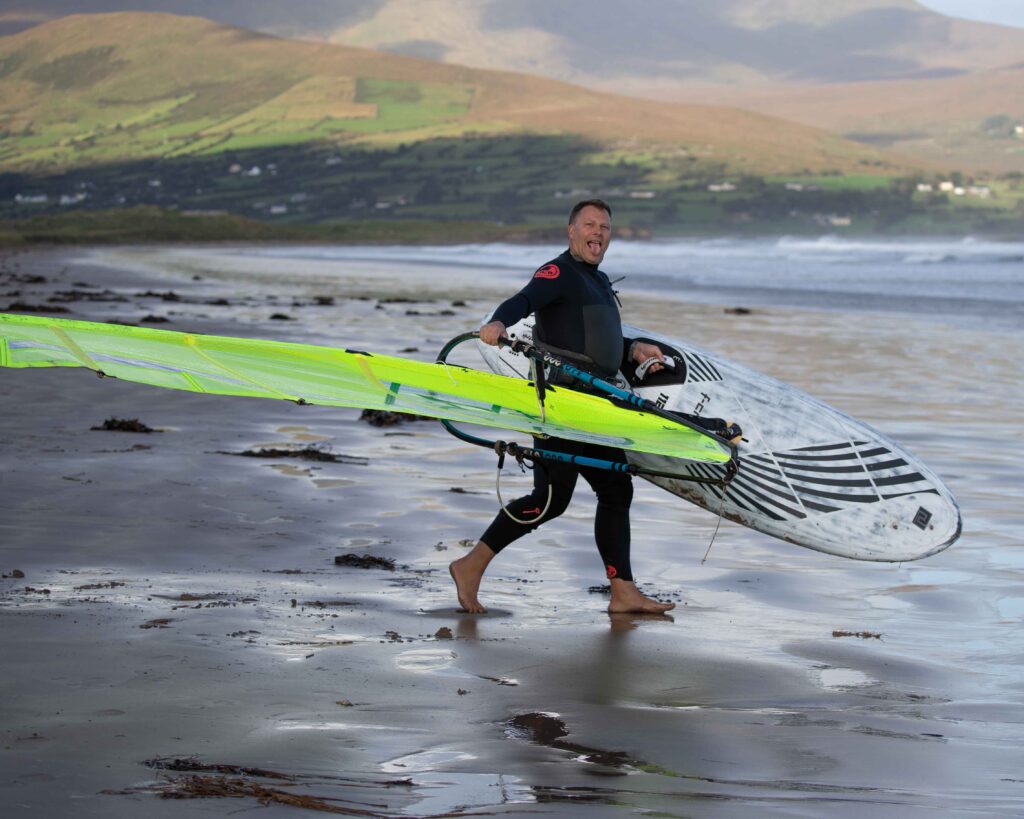
Wetsuit technology has improved considerably over the years. A good quality suit will now keep you much warmer than before. It’s possible to get away with less thick wetsuits and still be toasty. Although we’d always suggest you err on the side of caution and not get yourself too cold. Otherwise that may result in ‘issues’ arising.
Many of the well known windsurfing and wetsuit brands produce specific water wear for the sport. This clobber has been designed and manufactured with cool air temperatures and colder water in mind. A good quality wetsuit is therefore essential for UK windsurfing.
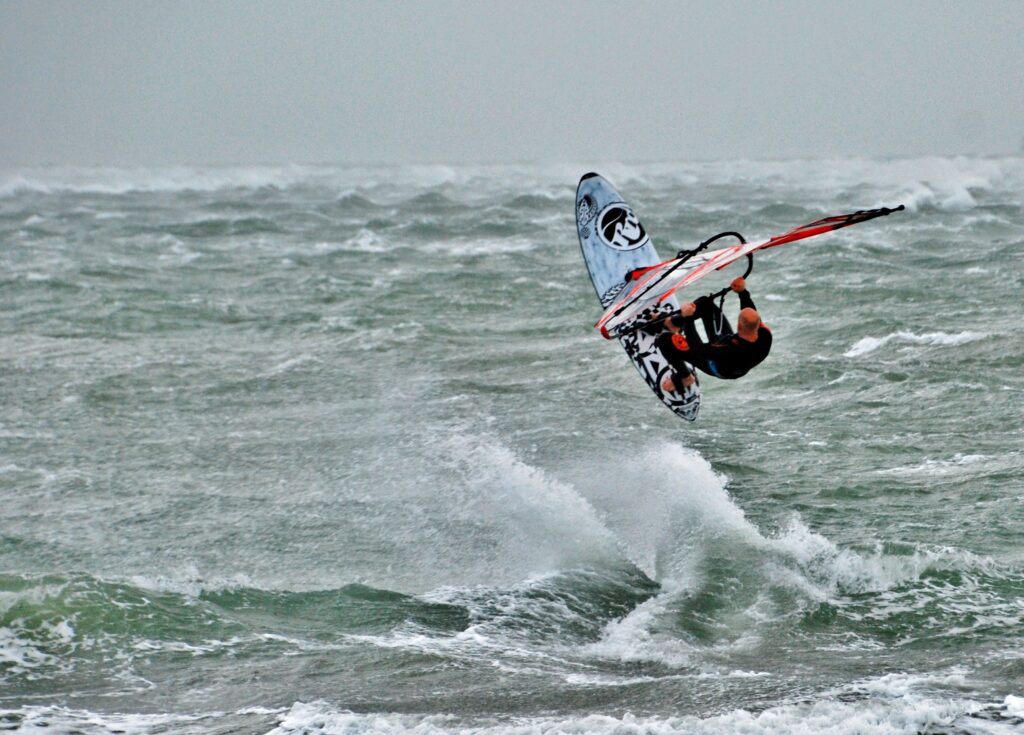
This all said warmer, windier days are plentiful through a typical UK windsurfing (high) season. It can be as pleasant as anywhere else globally on good days. And even though you may be rubbered up it’ll still be fun and isn’t an issue.
Windsurfing water wear suggestions –
Spring windsurfing – water temps will be at their coldest but air readings will be steadily rising. You may still need a 5/3mm or 6mm wetsuit. If it gets particularly warm a 4mm may be OK. Consider layering, with a thermal rash vest for instance, that can be removed if needs be.
Summer windsurfing – wind chill and evaporative cooling will still be in the mix even on the hottest of days. Your trusty 4mm will still be a go to piece of gear. But you may also be swapping to a 3mm wetsuit (perhaps with short arms) when conditions allow. Every now and again a shorty may be applicable. But don’t leave yourself open to hypothermia.
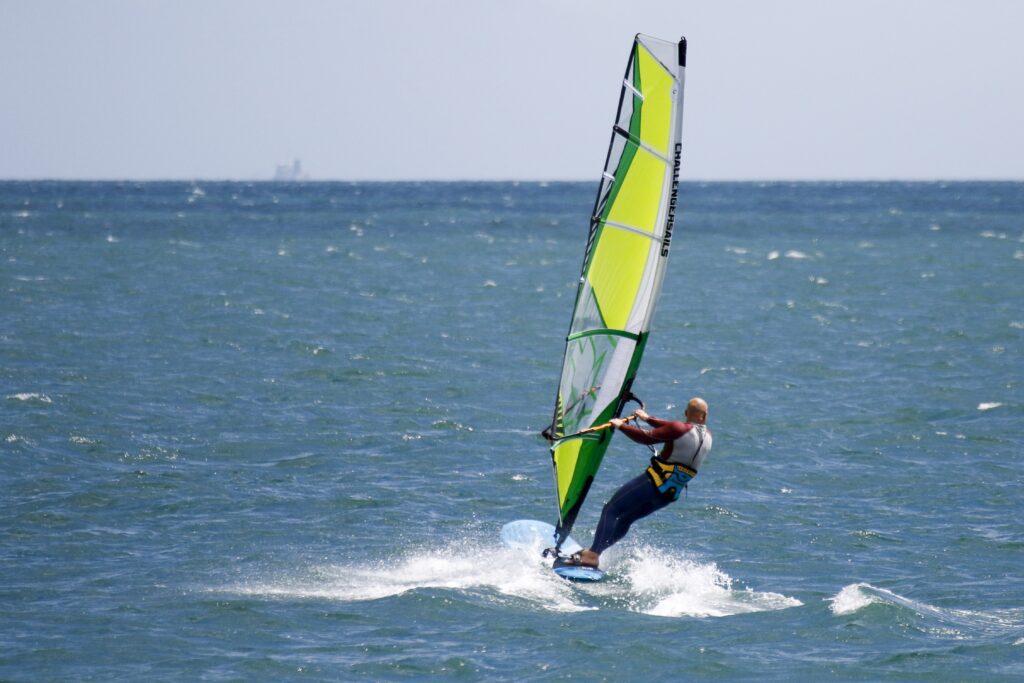
Autumn windsurfing – early autumn will see the water at its warmest with a few pleasant air temp days before it starts to get cold. It’ll most likely be back to 4mm suits for windsurfing unless we get extremely lucky with the weather. Around the middle of October, things can really cool down, at which point the winter wetsuit will be needed.
Winter windsurfing – if you’re riding during the off season then it’s thick wetsuits of 5/3mm-6mm. Early winter may still be mild (ish) but come New Year and the cold really ramps up. Don’t be a hero and try to get away with less protection – it’s just not worth it.
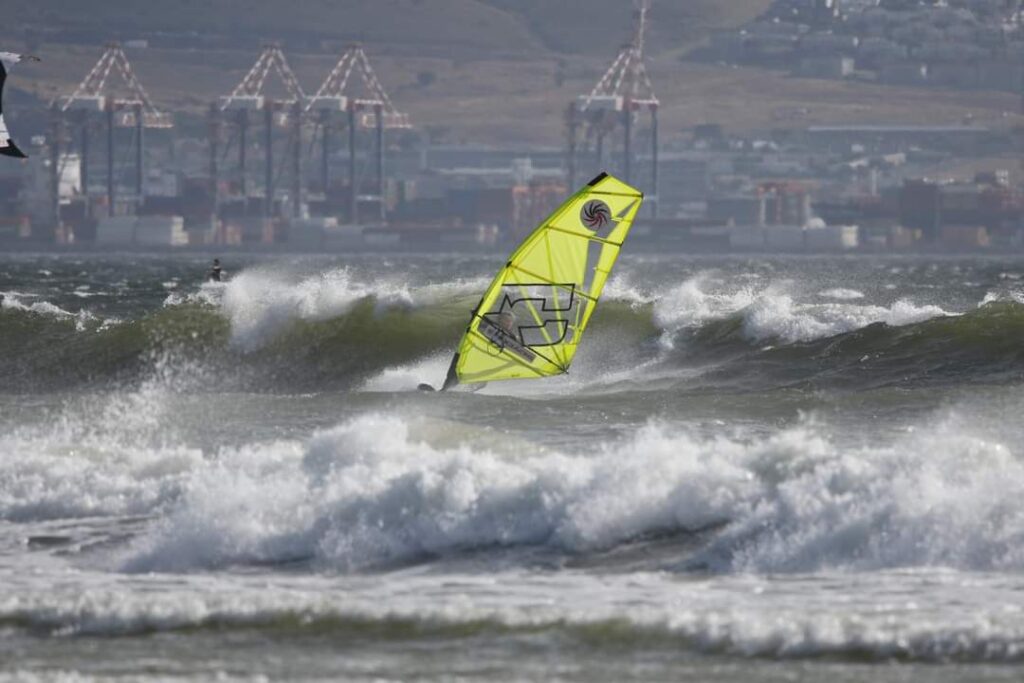
Do I need anything else for windsurfing?
Wetsuit accessories for windsurfing – things like rash vests, wetsuit boots, gloves and hoods/hats may be needed at times. Even in warmer months. Footwear can be dictated as much by the surfaces you’ll be standing on (either to launch/land or when in the water not riding) as by mercury levels. Gloves and hoods will probably be required for colder days (especially in winter) whereas rash vests may also be essentials right throughout the year.
In all cases, with wetsuits themselves and wetsuit accessories, it’s best to have the best quality kit you can afford. Speak to a reputable brand or retailer, who knows and understands windsurfing, to get the best advice.

This article from our friends at North Coast Wetsuits (a UK wetsuit brand who get windsurfing 100%) may guide you – https://www.northcoastwetsuits.co.uk/2023/01/ncw-wetsuits-for-windsurfing/
How do I get into windsurfing for the first time?
There are a number of routes to windsurfing nirvana. Sailing schools, windsurfing centres and outdoor education set ups are dotted around the UK in abundance. Many of those who provide windsurfing tuition do taster sessions. That could be a good way, in tandem with other activities, to see if you like the idea of windsurfing.
From there it’s always good to do a course whereby you’ll be shown the ropes by a qualified professional. It’ll take the hassle out of the process and speed things up considerably. Windsurfing is very much a technique led sport so having someone guide you is essential. Going it alone can be a workable path but it’ll be much more arduous and a slower learning process.
What about learning to windsurf overseas?
Overseas holidays are another way to (literally) test the water. Activity holiday companies such as Neilson and Mark Warner have all the windsurfing kit you’ll need. As well as tuition and access to warm weather. There are plenty more windsurfing providers in areas around the world who offer flexible windsurfing lessons.
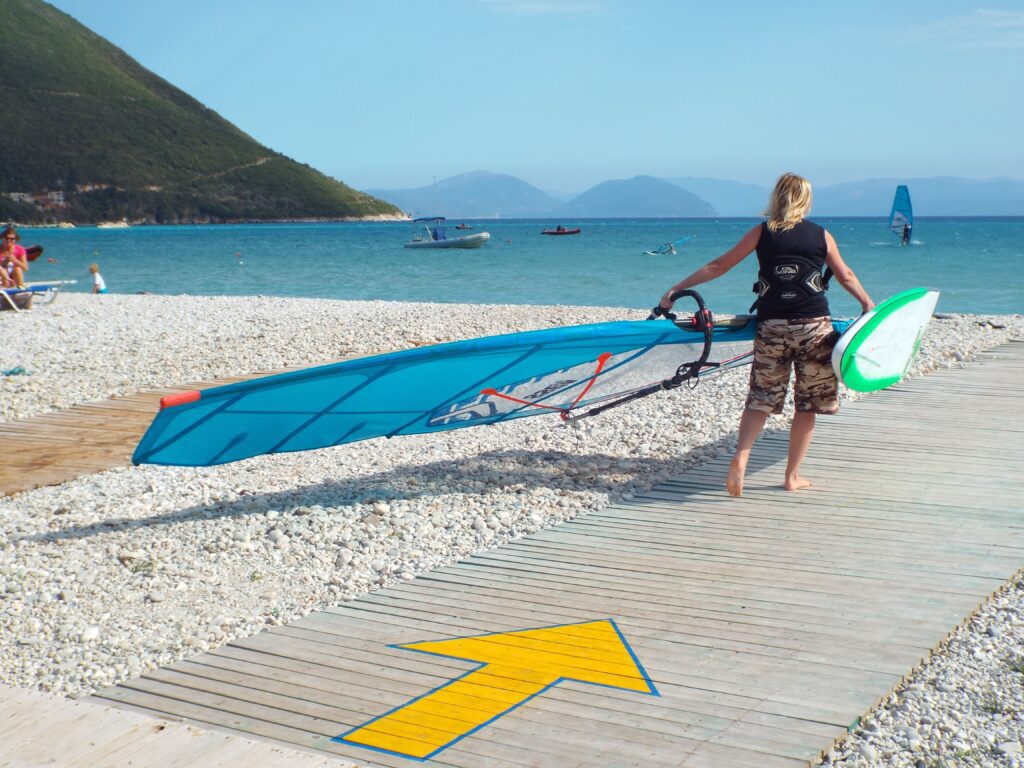
A few tried and tested overseas windsurfing locations good for beginners include (there are plenty more) –
- The Canary Islands (Lanazrote’s Costa Teguise and Fuerteventura’s Sotavento particularly).
- Vassiliki, Lefkas, Greece.
- Mar Menor, Murcia, Spain.
- Porto Pollo, Sardinia, Italy.
- Lake Garda, Italy.
- Leucate lakes, France.
- Bol, Brac, Croatia.
- Dahab, Egypt.
What kit do I need for beginner windsurfing?
As a beginner, your choice of windsurfing kit needs to be as easy as possible to use. Boards that are good for learning are wide with plenty of volume to keep you afloat. They’re stable and have a daggerboard or central fin underneath to stop downwind drift.
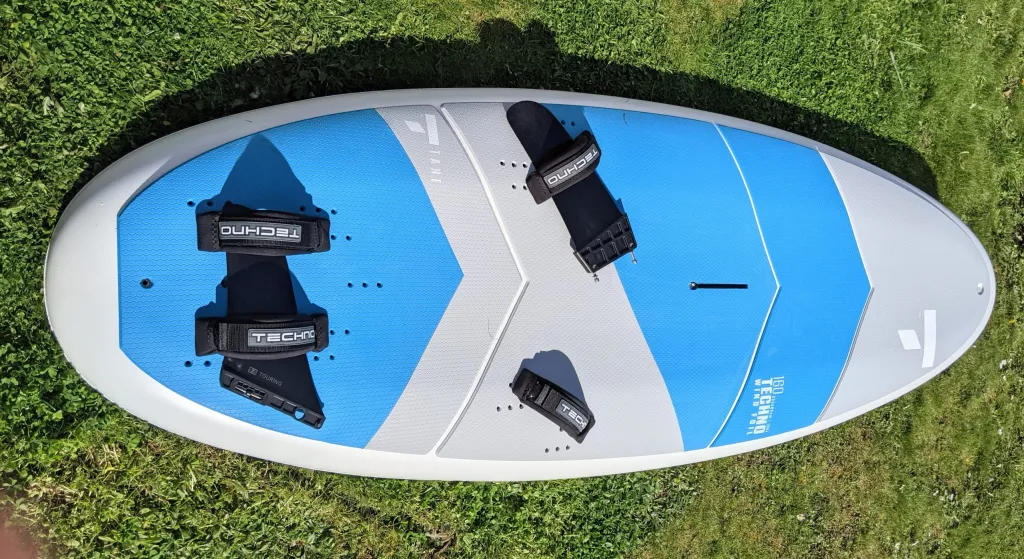
Other features such as soft EVA deck padding will be welcome when you’re clambering on and off the board. Hard decks can be abrasive to knees and elbows. Ideally, your beginner board will also allow riders to plane and learn how to get in the footstraps. This’ll mean it has more longevity and gives additional bang for buck. The last thing anyone wants is having to get rid of kit after a short period of time.
Sails (rigs) should be as lightweight as possible and make the whole windsurfing process simple. A 5m, for the averaged sized/build individual, will work fine. Those of smaller stature may need to go smaller, perhaps down to 4m. Ultimately your rig choice should have enough power to propel you along in light to moderate airs (5-15 knots).
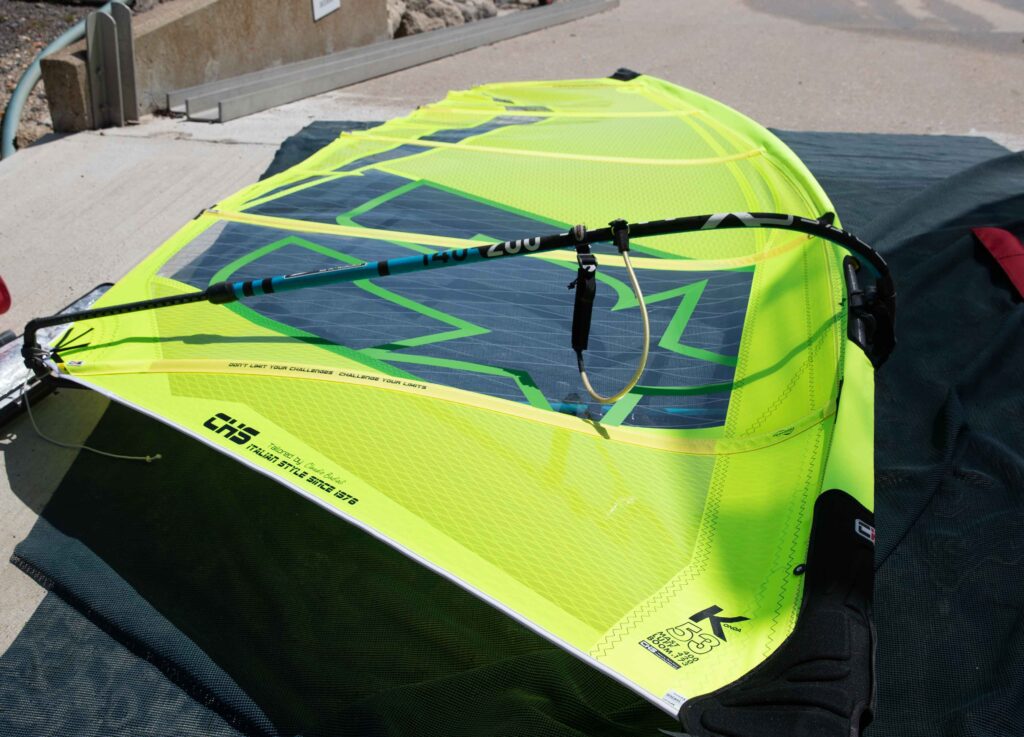
If you’re keen to commit, the best thing to do is head along to your local windsurfing shop where they’ll give you all the advice you need as far as boards. From a rig and sail point of view they’ll do the same or, alternatively, get in touch with us here at Challenger Sails UK for some tip top advice. We can provide all you need rig and sail wise to get you going properly.
What about advanced windsurfing gear?
As you improve you’ll no doubt want to fine tune your equipment – depending on your aspirations, style and skill. Windsurfing, as much as it does have a steep learning curve, still takes time. For many, it can be a lifelong pursuit of constant improvement and refinement.
After those initial forays and getting to grips with windsurfing’s basic elements it’ll probably be the freeriding path you’ve embarked upon. Freeriding is everyman windsurfing. Blasting back and forth, with gybes (or tacks) at either end of your run. You’ll mostly be doing this in light to moderate winds, topping out around 25 knots ish. We’re generalising here, as there’ll always be those who advance quicker and will move in the realms of wave sailing, freestyle, slalom and foil.
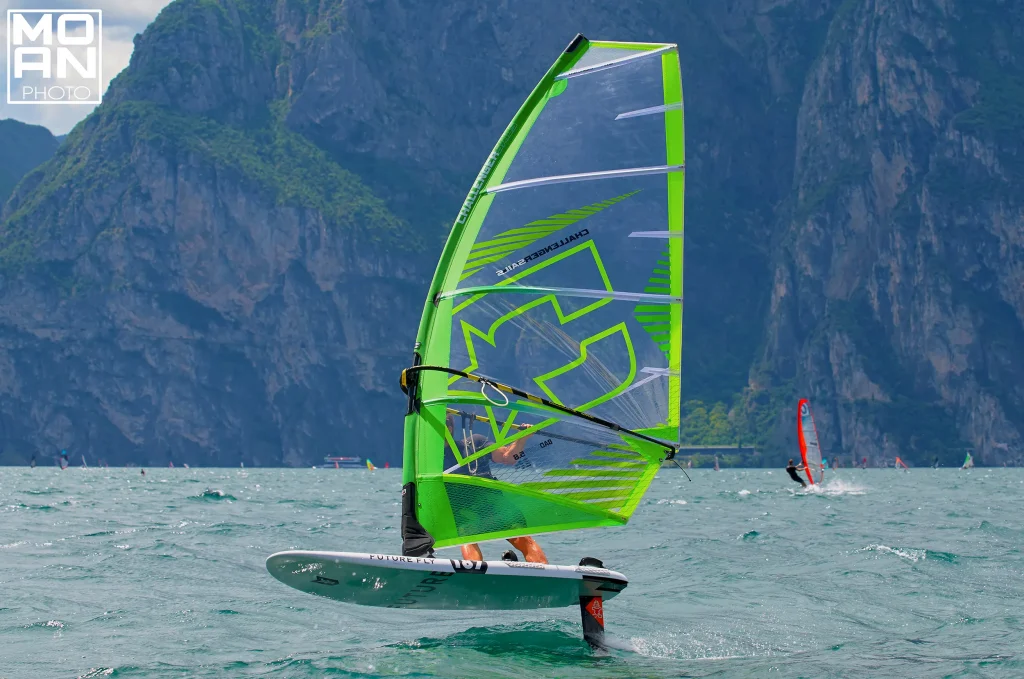
If it is the performance freeride area you’re tackling then your kit should match that. A board that allows riders to maximise freeride conditions will therefore be the go. Depending on your weight it’ll probably be something between 100L and 140L. A freeride board in this size category will be early planing, yet allow you to slog comfortably should the wind die. It’ll be quick enough, although not full on slalom performance. And there’ll be a healthy dollop of manoeuvrability built in, even if not a true wave thoroughbred.
Due to Mother Nature’s ever changing moods a quiver of sails will also be needed. It’s possible to keep this at just two with one boom, mast and accessories. Most riders tend to go for three though. This’ll give you the best range to cover all the usual wind scenarios you find yourself facing.
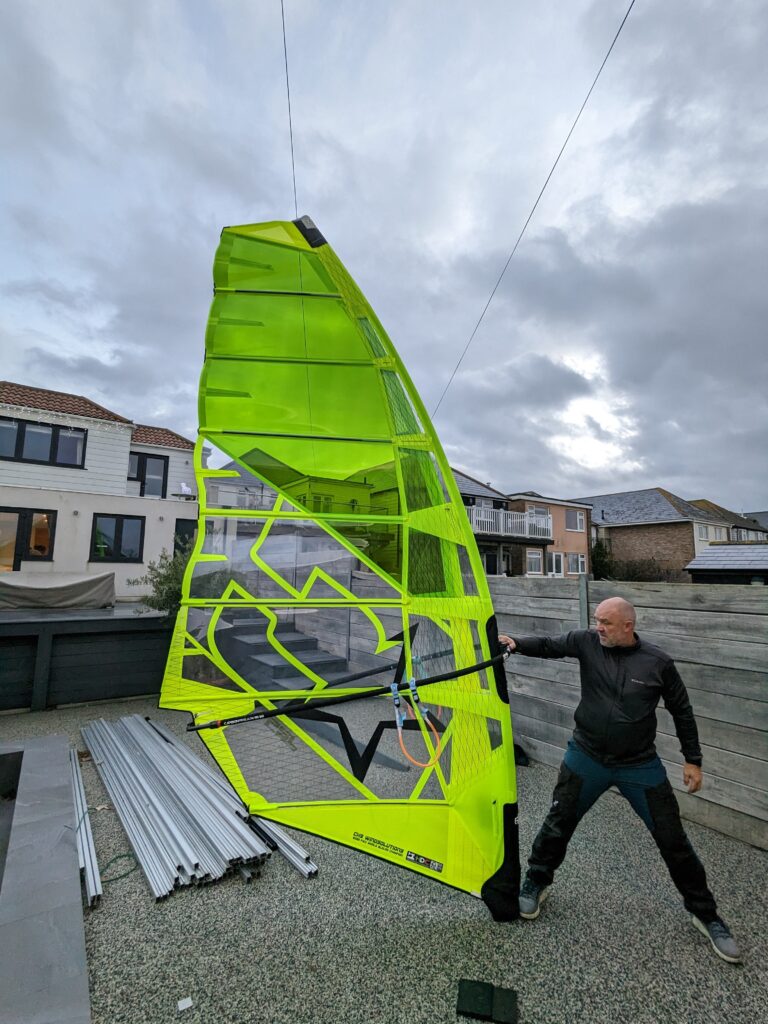
Challenger Sails UK can provide you with a cost effective quiver or tried and tested sail designs. Get in touch to see how.
Also, don’t forget your harness. A waist harness is the go to these days as these offer the best of all worlds in terms of performance. Make sure you get the correct fitting one. It should then last you a while.
Moving on from freeride windsurfing.
Do we ever really move on from freeriding? Even if we progress into specialist areas there’s nothing that beats blasting back and forth at speed. You may end up a wave sailor, wanting to rip, shred and tear. But chances are you’ll still blast back and forth with a big grin on your chops at certain points. Even if just getting out back, beyond the breaking waves.
Also, the UK’s weather means you may WANT certain conditions. But often you GET what you’re given. That means blasting is never really going to leave your agenda. Otherwise you’ll limit yourself and your windsurfing too much which will see little time afloat. This is a scenario whereby experienced sailors end up getting disillusioned with the sport. When actually a bit of back and forth in the sun is good for all riders, regardless of specific taste and style. Our advice: don’t get sucked into the rut of being a windsurfing snob.
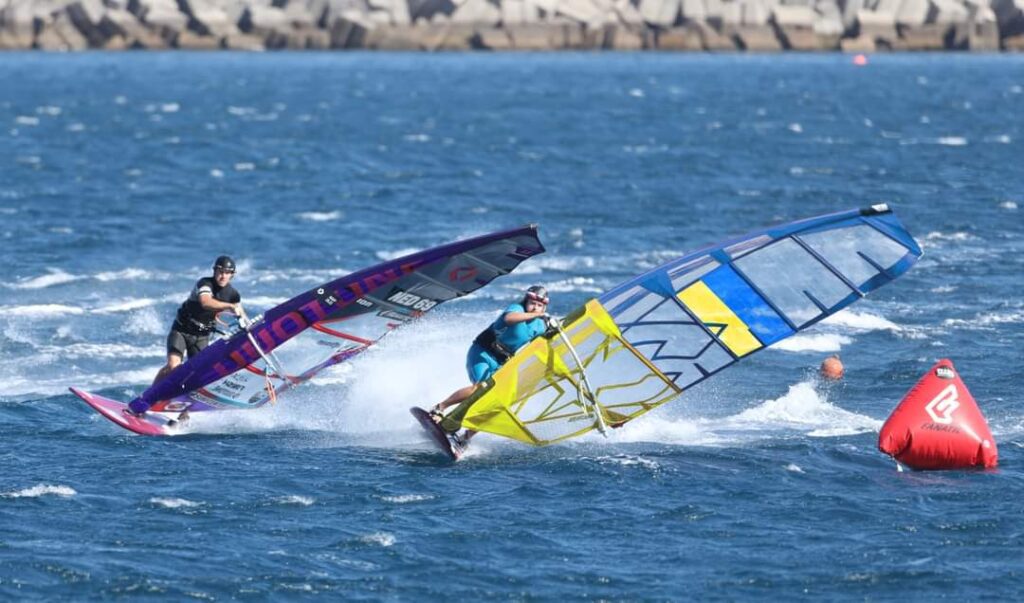
Nonetheless, as your windsurfing skills continue to evolve you may start looking at certain types of windsurfing.
Here’re what these will probably be –
- Wave sailing – sailing in waves,riding swell like a surfer, with aerial jumps and tricks in the mix too.
- Freestyle – falter water spins and moves in a similar vein to snowboarding or skateboarding.
- Slalom – going fast, racing other riders and aiming to win!
- Windsurf foiling – flying above the water, via hydrofoil power, in lighter breeze.
- Longboard sailing – either planing or non-planing longboard sailing still fits the bill for many, even though it’s often thought of as old school.
- Wingsurfing (wing foiling) – a hybrid cousin of windsurfing the newest watersports kid on the block is all about flying above water via hydrofoil power with a handheld, inflatable wing as your engine.
- WindSUP – utilising a stand up paddle board, with windsurf rig attachment, for light breeze fun. A little like longboarding but without the efficiency. Many windSUPers use their kit for light wind wave sailing antics.
Is windsurfing just about sailing on the water?
The simple answer is: no! As with all watersports (and sports concerning the elements), riders need a solid bank of knowledge pertaining to all aspects. This would include –
- How to read and interpret a weather forecast.
- Having a grasp and understanding what tides mean.
- Knowing how to ‘read’ the wind and water state at any given spot (The Beaufort Scale will help with this).
- Having a grasp of windsurfing equipment design and how this might potentially affect your performance in the water.
- Being able to ‘read’ waves and swell (if you’re sailing in such locations).
- Understanding windsurfing safety and how to get yourself out of a pickle.
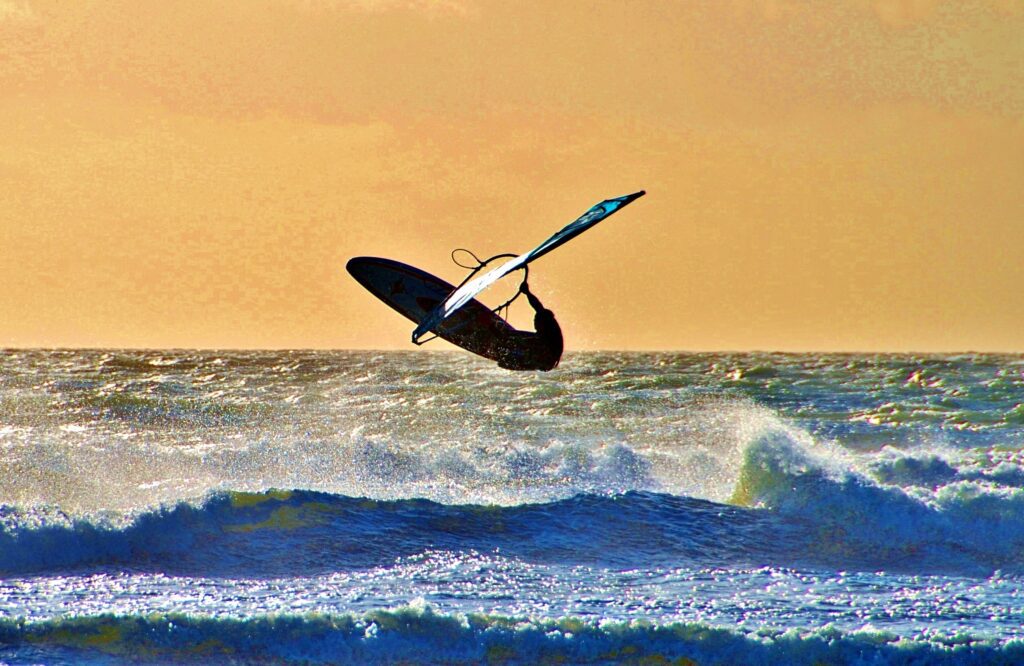
There’s a whole raft of other windsurfing knowledge that you’ll need to acquire. As you go down the path of windsurfing much of this will be gleaned on the journey. At first, it all seems daunting but it does get easier. Much of it you simply end up knowing through osmosis. If you’re unsure of any aspect regarding windsurfing then it’s worth consulting those who know. Windsurf coaches/instructors, as we’ve already said, are great sources of information. The many social media windsurfing groups are pretty good too. Especially if it comes to location data and how these spots work.
Is there windsurfing lingo I need to know?
At the risk of sounding like you’re about to start using surf speak (think cliched surfing isms) windsurfing does carry its own specific language. Much of it’s related to the sport itself rather than get ‘duded up’.
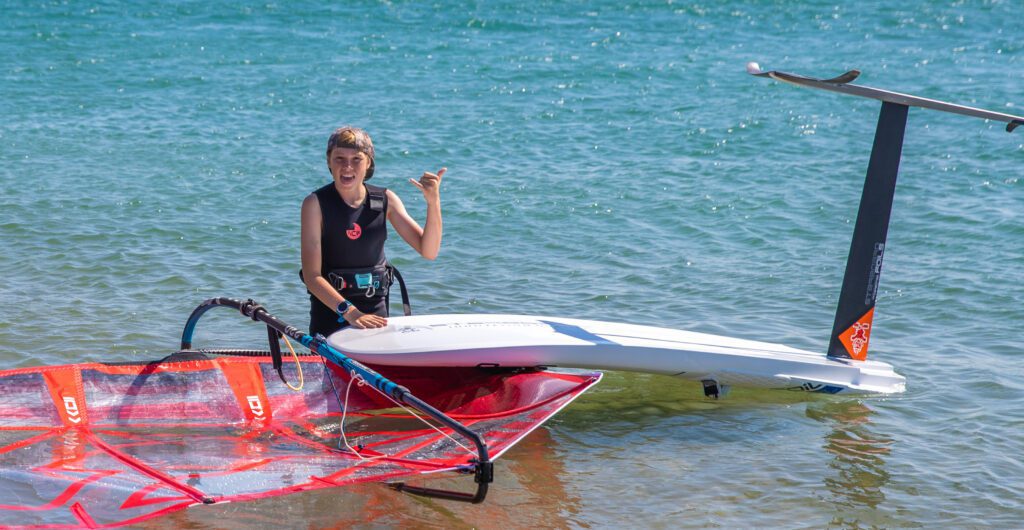
Here’s a selection of windsurfing jargon and what it means (there’s much more) –
- Onshore/cross shore/offshore/side shore – the direction of wind relating to your position on the beach.
- Rig – the combination of sail, boom, mast and extension.
- Straps – what you put your feet into.
- Deck – top of the board.
- Hull – the board’s underside.
- UJ – (universal joint) what you rig attaches to the board via.
- Harness – what you wear and use to hang from a harness line.
- Harness line(s) – a moulded loop whereby sailors attach themselves to the rig via a harness.
- Howling – strong breeze.
- Gusty – inconsistent wind that fluctuates in strength.
- Sea breeze – summer wind phenomenon caused by convection current.
- Thermal wind – breeze found in effect when it’s warm (usually hot countries).
- Port tack – sailing left hand/foot forward.
- Starboard tack – sailing right hand/foot forward.
- Down the line – the direction of wind relating to waves and how you as a windsurfer interact with these elements. In down the line (DTL) scenarios the wind blows cross offshore as opposed to onshore. This makes the wave cleaner and better for actual wave riding.
- Planing – your board rises, overtakes its bow wave, rides off the fin and skips across the water at speed like a stone.
- Gybe – downwind turn.
- Tack – upwind turn.
- Pop – a small olly style jump.
- Jump – getting airborne.
- Aerial – usually a jump performed using a wave as a launch pad.
- Tweak – contorting your body through a move.
- Chop – small wavelets formed on the water when it’s breezy.
- Swell – the incoming pulse of ocean energy that turns into a breaking wave.
- Rip – strong ocean current born of expended wave energy flowing back out to sea via path of least resistance.
- Ripping – surf slang for a rider that sails well.
- Stoked – surf slang for contentment and fulfilment.
Windsurfing competition – do I need to be a pro to enter?
There are many windsurfing comps around the country each year. From grassroots level racing to more headline wave sailing events. For any rider who thinks they’re likely to enjoy competitions, you’re free to test your mettle in whatever discipline chosen.
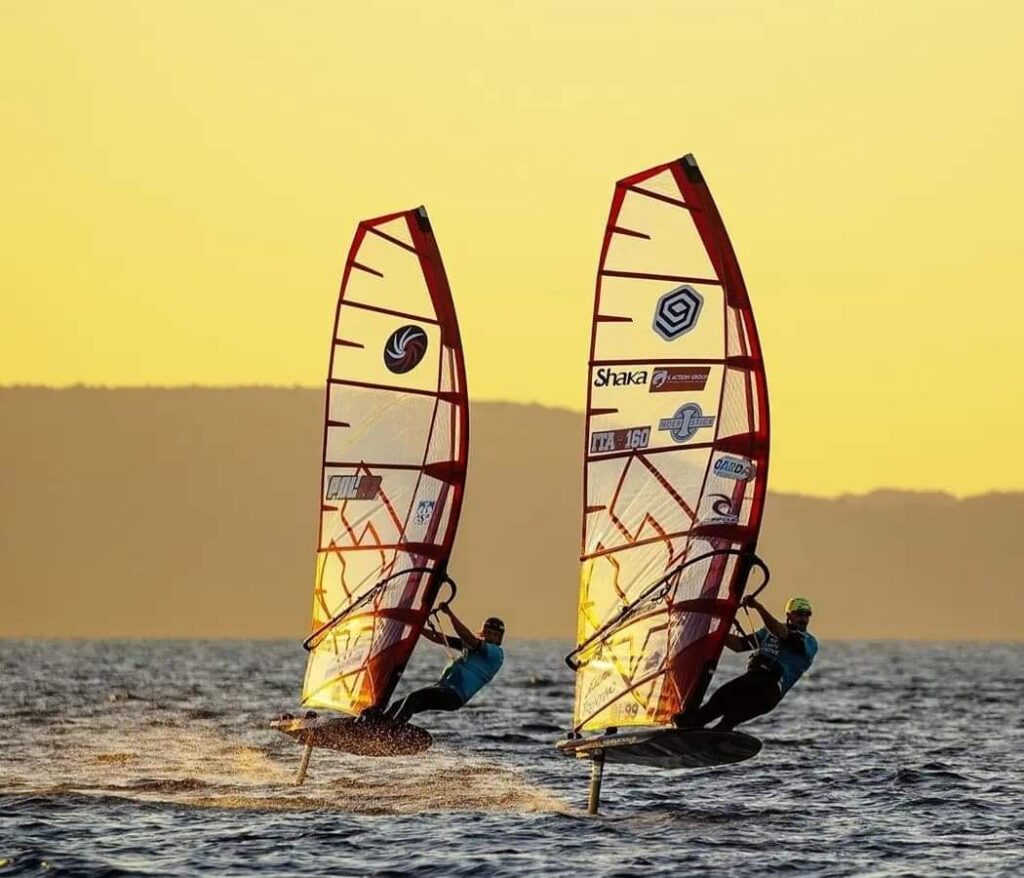
Of course, if it’s a wave event then you need to be a competent sailor in strong winds and coastal, surf conditions. Otherwise it’ll be an unsafe prospect. But you don’t need to be a pro. There are classes for all comers. It’s a case of committing and getting involved.
Most competition windsurfers will tell you it’s more about camaraderie rather than winning and losing. Riders support one another, and whilst there are podium finishes, it’s no shame to have entered and done your best. In terms of improvement, windsurfing competition is a sure fire way to improve. There’s much experience on tap so great to sponge that all in.
What about kiddy and youth windsurfing?
Just as with adults, there’s every reason to get your offspring involved with the sport. These days there’s great equipment available that’s specific for children who windsurf. Gone are the days needing to use mum and dad’s cast offs. Kiddy windsurfing kit has its geometry making it aligned to the stature of little ones.
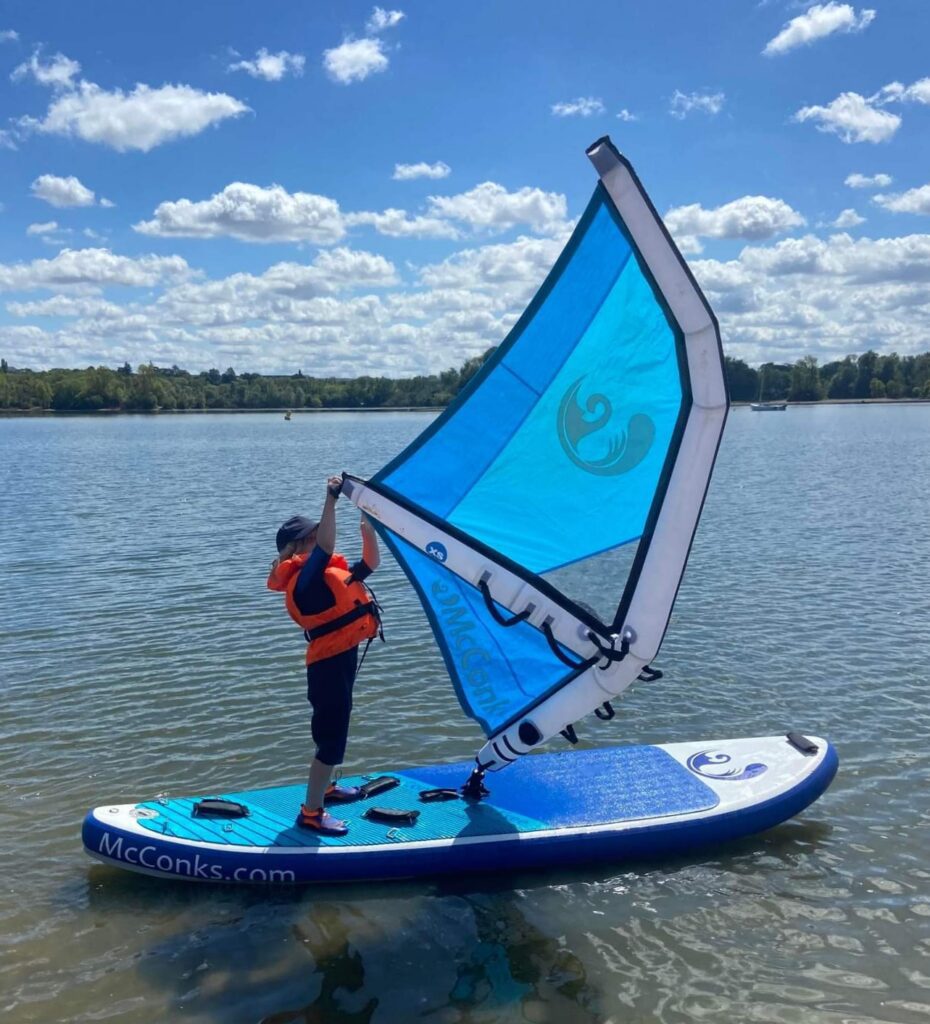
Some say it’s best to start your kids windsurfing around the age of eight. But it depends very much on circumstance. We know a few young sailors who’ve started much earlier than this. Equipment like inflatable windsurf sails (which are extremely light) used in super sheltered, shallow locations means two year olds can begin.
Parents do need patience as not every child will gravitate towards the sport. The worse thing is to force the issue. Make things fun and no hassle to see many smiles and laughs. In time, should the child in question get truly bug bitten then they’re free to take things as far as they wish.
Some choices of venue great for kids as follows (there are plenty more available) –
- Hayling Island Sailing Club (HISC) high tide lagoon – waist deep water two hours either side of high tide. Membership does apply though.
- Mudeford Harbour – high tide, shallow water with instruction and equipment hire available through high season.
- Poole Harbour – large expanse of tidal water that’s a tried and tested classic for all riders.
- Roadford Lake – fresh water body of water found on the border of Cornwall/Devon that’s safe and great for kids to learn.
- Loch Bhasapol (Tiree) – sheltered, shallow windsurfing lake in an awe inspiring place.
- Llandegfedd Reservoir – sheltered Welsh lake that’s perfect for learning.
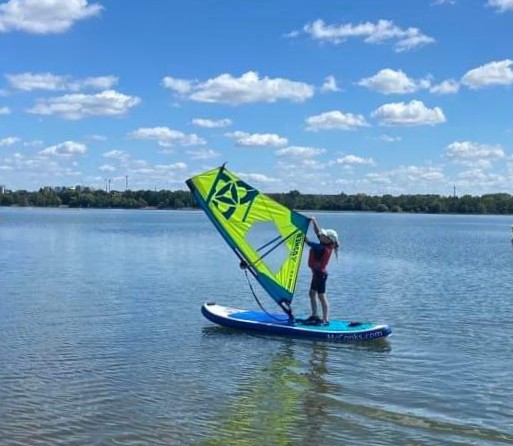
A note on light wind windsurfing.
Windsurfing isn’t just about high winds and big waves – as some will have you believe. Even on light air days, with the sun shining, there’s plenty of reason to get out and enjoy the outdoors.
During the 90s windsurfing went way too performance orientated. Kit required hurricane wind and pro levels of ability to get the most out of it. That put many riders off, as you can imagine. More recently the industry at large has done much work to make windsurfing more accessible again. Your standard, floaty freeride board is very applicable to some light wind cruising. Or, alternatively, go the whole hog and grab something that’s even more efficient for low wind days.
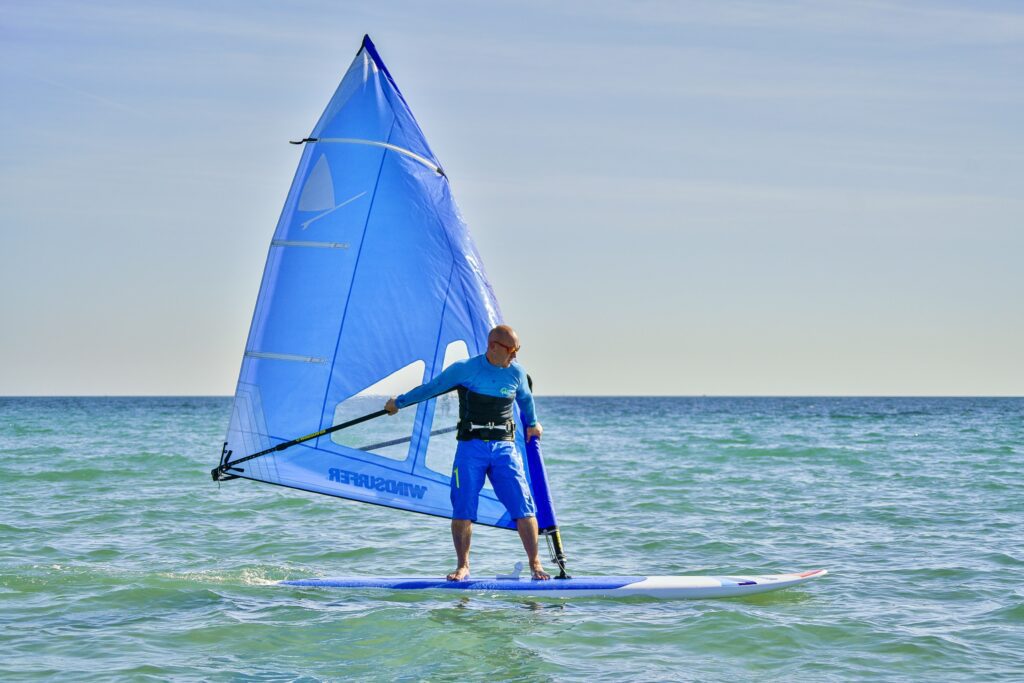
Check any of the usual marketplace websites and you’ll find longboard style windy boards going for a song. They might be older bits of kit but they still work great and are poised to get you having some windsurfing fun whatever the weather. And all without breaking the bank.
When the wind turns back on you can then bust out your standard windsurfing kit for a blast. There’s nothing worse than sitting on the beach looking forlornly out to a flat calm sea. Get off your behind and have some fun instead!
Summing up.
Becoming a windsurfer is much easier than, say, becoming a surfer. You don’t need waves for a start – even though that’s a thing you can move onto if you wish. All you need to do is make that jump and get a few lessons. Then take things step by step. Pretty soon you’ll be blasting around your local area with the best of them.
Windsurfing also doesn’t need to be super expensive. There are some great equipment deals to be had if you keep your eyes and ears peeled.
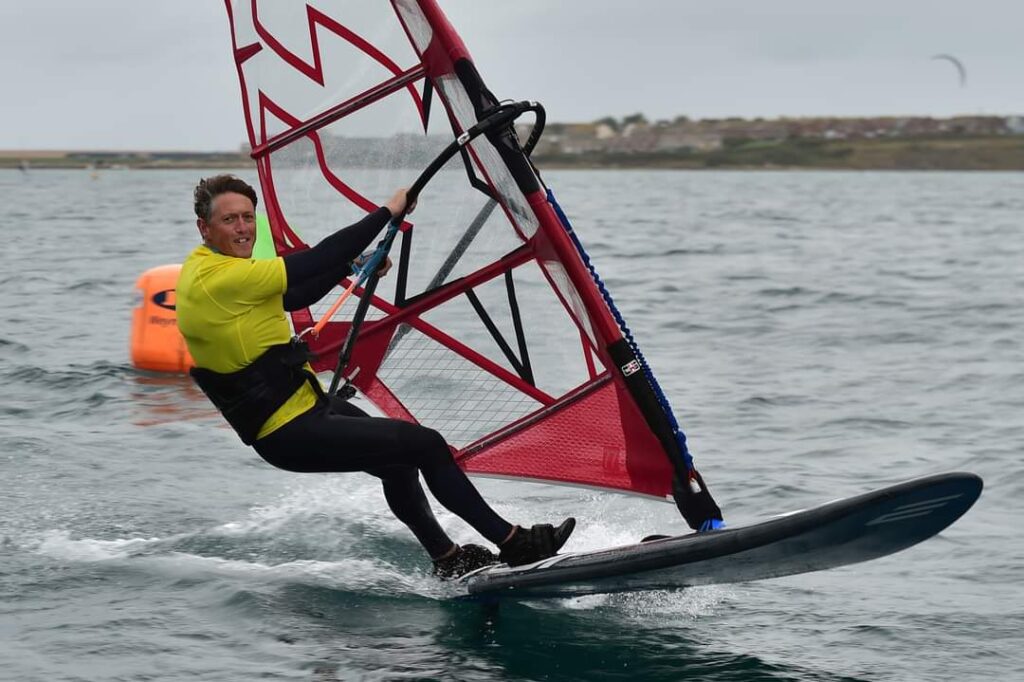
Even new gear deals if you know where to go – Challenger Sails UK has bargains available if you get in touch.
Take it from us: windsurfing is a super fun, healthy and a dynamic hobby that all the family can enjoy. Ignore the hype. Windsurfing can be as hardcore or mellow as you like. The main thing is that you get outside and enjoy the environment in a natural way. You’ll be all the happier and more content for it!
If you have any more windsurfing questions get in touch with us at [email protected]
